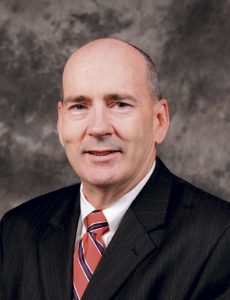COMMERCIAL AUTO INSURANCE
Is the road finally clearing for this long-distressed line of coverage?
By Joseph S. Harrington, CPCU
Is commercial auto insurance, a severely distressed line of business over the past decade, finally turning the corner toward profitability, or at least sustainability?
In May 2021, Fitch Ratings reported that commercial auto’s combined ratio improved nearly eight percentage points from the previous year, falling from 109.4% in 2019 to 101.6% in 2020. That dramatic improvement is credited to a 26% decline in the frequency of liability claims in a year when the amount of driving was constrained by the COVID-19 pandemic.
Yet, even as traffic returns to normal levels, Fitch anticipates that “further marginal performance improvement” will lead to an “approximate break-evenl evel” in the 2021 combined ratio.
Nick Saeger, assistant vice president for transportation products, pricing, and underwriting for Sentry Insurance, characterizes today’s commercial auto market as “on the road to recovery”—thanks to some strong medicine. “With [severity] loss trends approaching double digit increases, the industry needs to get double digit rate increases to move the needle on underwriting profitability,” he says. “We’re seeing that, but there likely needs to be more of it.”
“Market conditions continue to be challenging, with a continued lack of capacity coupled with high rates,” says Pat Stoik, chief risk officer for Overhaul, a company specializing in supply chain risk management. “These challenging conditions are driven by the continued poor underwriting results,” he says. “Double-digit renewal increases continue to be the norm for under-performing motor carriers, while even the best struggle to obtain reasonable pricing.”
Stoik sees technology-supported assistance to motor carriers as key to promoting safety cultures that will reduce the frequency and severity of accidents, “and lead to a more reasonable insurance market as results improve.”
Whip-sawed
Complicating conditions in the line is the manner in which motor carriers have been whip-sawed by pandemic conditions.
By reducing driving and temporarily closing courts, the COVID-19 pandemic provided some relief from the impact of attorney advertising, litigation financing, and social inflation on commercial auto loss severities, observes Lindsay Guerrant, small commercial lines product strategy lead for Liberty Mutual. But just as there has been some relief for bodily injury claims, she finds that physical damage losses have been hit by a shortage of microchips that have slowed production of new vehicles and driven up the cost of total losses.
“Throughout 2020, reduced economic activity resulted in reduced loss frequency, while loss severity continued to increase,” says Dennis McGuire, casualty underwriting leader for Nationwide. “As the economy began its recovery, loss activity also picked up.
“Fleet operators continue to be challenged in hiring and retaining safe, experienced drivers,” he adds, “while pandemic-related supply chain delays have created parts shortages.”
Labor and materials shortages are driving up claim severity at the same time loss frequency is returning to pre-pandemic levels, according to Michael Teng, Sentry’s assistant vice president of regional product, pricing, and underwriting. “Claim frequency has risen during the spring and summer of 2021,” he says. “The dip in claim frequency was only temporary.”
Pandemic recovery
Despite its challenges, business is improving for the commercial trucking sector as pandemic conditions abate.
“Initially, during the widespread shutdowns, you saw certain segments of the trucking industry having to park trucks and scramble to stay in business,” says Saeger. “We worked with our agents and customers to find solutions and, for the most part, our customers were able to recover and continue to move goods.
“Since then, the trucking industry has experienced tremendous prosperity,” he adds. “We’ve seen our renewal book grow as truckers race to meet demand.”
A principal impact of the pandemic lockdowns of 2020 was increased demand for delivery service, especially by restaurants, according to Guerrant.
“Many small businesses that did not deliver previously began doing so,” she says. “Many were left with gaps in coverage because of it. Today, it is more important than ever for agents to reach out and discuss auto usage with their small commercial clients.
“Gig workers will typically have access to a basic commercial auto policy through their delivery service,” she explains, “but a gap in coverage can arise for the goods during shipment. As delivery operations scale up, these gaps become bigger and questions about coverage become more complex.”

“Double-digit renewal increases continue to be the norm for underperforming motor carriers, while even the best struggle to obtain reasonable pricing.”
—Pat Stoik
Chief Risk Officer
Overhaul

Carrier actions
Despite signs of improvement in the commercial auto insurance market, agents and brokers will have to be patient about seeking flexibility from commercial auto underwriters.
“Broadly speaking, rates simply need to increase, and sometimes rather significantly,” says Saeger. “On top of rate increases, you’re definitely seeing some stricter underwriting decisions. The industry is still battling loss trend headwinds.”
“Poor performance has impacted underwriting, pricing, and loss control,” says McGuire. “There has been a steady upward trajectory in pricing, and close scrutiny of fleet composition, prior performance, driver selection, and management. Loss control support is critical for execution of action plans needed to address fleet deficiencies.”
“Commercial auto premiums have risen throughout 2021, and will likely continue to do so for the foreseeable future,” says Guerrant. “That said, as market conditions begin to stabilize and the realities of a post-pandemic world become clearer, the increases are also likely to stabilize.
“In these challenging conditions, agents have an opportunity to help insureds navigate the market,” she adds. “Risk mitigation education is an area of opportunity, and many carriers offer services that help policyholders prevent a loss before it happens.”

“Fleet operators continue to be challenged in hiring and retaining safe, experienced drivers, while pandemic-related supply chain delays have created parts shortages.”
—Dennis McGuire
Casualty Underwriting Leader
Nationwide
Producer role
“Educating clients on their risk exposure is perhaps the greatest value agents and brokers can bring to a client relationship,” Guerrant says. “Commercial auto insurance is complex, and it’s the ease of choice and advice that differentiates one agent from another in these challenging market conditions.”

“Many small businesses that did not deliver previously began doing so. Many were left with gaps in coverage because of it.”
—Lindsay Guerrant
Small Commercial Lines Product Strategy Lead
Liberty Mutual
“Agents have a tremendous opportunity to be an educational resource for their customers,” says Dan Clements, Sentry’s director of sales for transportation insurance.
“Help your customers understand why insurance premiums continue to rise. Show them the coverage options you can provide. Teach them what plaintiff attorneys are looking for and what a motor carrier should do to defend itself.”
Clements sees great challenges and opportunity in a market in transition.
“Rising premiums have attracted many new agents to commercial auto, and competition for new business is fierce,” he says. “On the other hand, many markets have dialed back their appetite for new business, restricted access to their programs, or exited the space altogether.
“With many agents after the same business and fewer strong, unique markets to represent, differentiating yourself from your competition has become the biggest challenge for an agency.”

“Rising premiums have attracted many new agents to commercial auto, and competition for new business is fierce. On the other hand, many markets have dialed back their appetite … .”
—Dan Clements
Director of Sales, Transportation
Sentry Insurance
For more information:
Liberty Mutual
www.libertymutual.com
Nationwide
www.nationwide.com
Overhaul
www.over-haul.com
Sentry Insurance
www.sentry.com
The author
Joseph S. Harrington, CPCU, is an independent business writer specializing in property and casualty insurance coverages and operations. For 21 years, Joe was the communications director for the American Association of Insurance Services (AAIS), a P-C advisory organization. Prior to that, Joe worked in journalism and as a reporter and editor in financial services.





